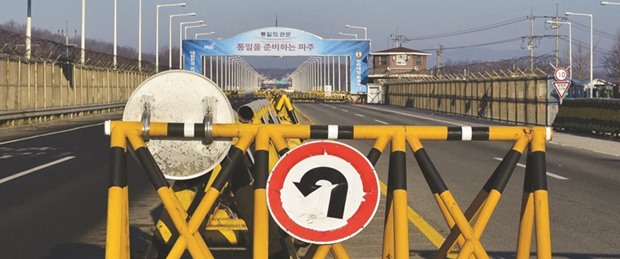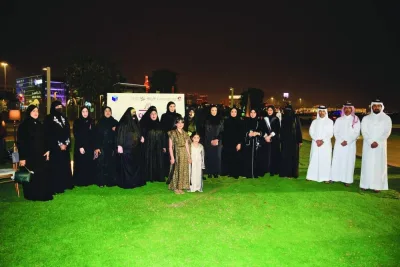South Korea will pull out of an industrial complex jointly run with North Korea, taking aim at their last remaining symbol of economic co-operation to punish the Kim Jong Un regime for its recent nuclear test and rocket launch.
“An extraordinary measure is needed to force North Korea to give up its nuclear arms,” South Korean Unification Minister Hong Yong Pyo said yesterday at a televised briefing. “Our government decided to entirely suspend the Gaeseong Industrial Complex to stop our companies and funds for Gaeseong from being used for North Korea’s nuclear and missile development.” The withdrawal will affect more than 120 South Korean companies employing about 54,000 North Korean workers at the complex that sits just north of the heavily armed border between the countries. South Korea is trying to dry up North Korea’s coffers while China’s leaders remain reluctant to join sanctions that could destabilise an ally even after they condemned the Kim regime’s nuclear test on January 6 and rocket launch on February 7.
Gaeseong has long been viewed as a source of hard currency for the isolated government in Pyongyang, which had no immediate response to the decision. North Korea has received 616bn won ($516mn) in cash since the complex began in the early 2000’s, including 132bn won last year alone, Hong said.
South Korea’s government and private citizens have invested more than 1tn won, he said.
South Korea’s plan suggests President Park Geun Hye’s patience is running out despite her hopes for eventual unification as a source of economic prosperity. In 2014, less than a year after taking office, she said that unification between the two countries would be an “economic bonanza” for the combined 75mn population on the peninsula.
The industrial park served as a testing ground for a unified Korean economy by merging South Korean know-how and capital with North Korea’s cheap labour. Companies operating there have mostly produced labour-intensive goods, including Romanson Co, a watch maker, Shinwon Corp, a clothing manufacturer, and Good People Co, an underwear maker.
“This is a strong message to North Korea and a rallying cry for more international sanctions and pressure against Pyongyang,” said Chang Yong Seok, a researcher at the Institute for Peace and Unification Studies at Seoul National University.
“The complex has been an obstacle to South Korean, US and Japanese efforts to increase their independent sanctions against North Korea apart from UN sanctions.”
Japan’s National Security Council yesterday imposed new sanctions on North Korea, including a ban on all North Korean ships from entering the country.
China provides most of North Korea’s energy and food imports and has repeatedly rejected tough sanctions like banning oil exports for fear of destabilising North Korea and triggering a flood of refugees across the countries’ shared border.
“Without the trade and currency from Gaeseong, North Korea’s economy will depend almost solely on China,” said Robert Kelly, a professor of political science and international relations at Pusan National University in South Korea. “China seems prepared to put up with a lot of North Korea’s misbehaviour. If China doesn’t do something very serious on North Korea soon, then President Park will never go back to Beijing. How much more can China put up with?”
In response to North Korea’s growing capabilities, South Korea and the US said they would begin talks about the deployment on the peninsula of an American ballistic missile defence system known as Thaad. China said it is “deeply concerned” about the talks on Thaad, calling it a source of more tensions between the two Koreas.
North Korea is developing a missile called Taepodong-2 with a range of 10,000 kilometres (about 6,200 miles), according to South Korea’s Defence Ministry. That would leave the West Coast of the US within the missile’s range. The rocket launched earlier this month showed technological developments “applicable to North Korea’s other long-range missile programmes,” US Defence Intelligence Agency Director Vincent Stewart said in a statement prepared for delivery on Tuesday to the Senate Armed Services Committee. The Gaeseong complex started production in 2004 and has since survived a spate of tensions stemming from North Korea’s nuclear and missile tests. In 2013, North Korea withdrew its workers for months following its third nuclear test, and returned them after the two countries agreed on steps to improve relations, including the reunions of families separated by the 1950-53 Korean War.
“Other than Gaeseong, there’s very little that links the South economically with the North. This closure is going to hit North Korea hard – in the pocket,” Kelly said. “The question is whether this is a suspension or a real closure.”
A Gaeseong business group immediately protested the move to pull out, saying the announcement gives companies little time to minimise losses. North Korea would probably try to export its Gaeseong workers to China while their South Korean employers would find it hard to hire workers cheaper than North Korean ones, according to Cheong Seong Chang, a senior analyst at the Sejong Institute near Seoul.
“North Korea’s damage from a closure of the Gaeseong complex may not be as big as South Korea expects,” Cheong said by text message. “The Gaeseong complex has been the only place for inter-Korean cooperation and its closure could lead to an entirely confrontational situation in the relations between the two Koreas.”

A barricade is set on the road leading to North Korea’s Gaeseong joint industrial complex at a South Korean military checkpoint in the border city of Paju near the demilitarised zone dividing the two Koreas. Seoul’s plan to withdraw all companies from the industrial complex will affect more than 120 South Korean firms employing about 54,000 North Korean workers at the complex that sits just north of the heavily armed border between the countries.


